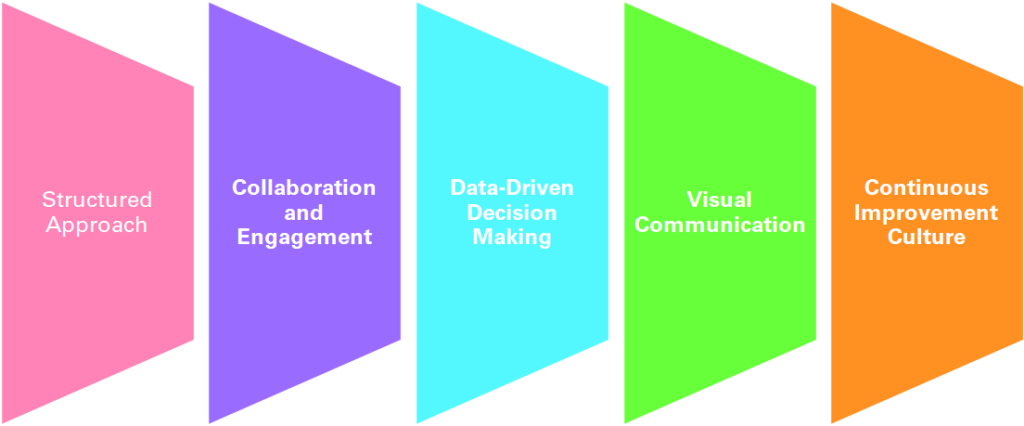In the fast-paced and competitive world of business, challenges and problems are inevitable. From operational bottlenecks to customer complaints, organizations need effective problem-solving techniques to overcome these hurdles and drive success. In our previous blog post on the “Top Ten Proven Problem-Solving Techniques and Frameworks,” we explored a range of powerful approaches for addressing business problems. In this article, we’ll focus on one of those techniques: A3 Problem-Solving. Derived from the paper size “A3,” this methodology provides a structured framework for analyzing complex problems, identifying root causes, and developing actionable solutions. By delving into various scenarios and showcasing the versatility of A3 Problem-Solving, we’ll highlight how this technique can empower organizations to effectively navigate their most pressing challenges.
Understanding A3 Problem-Solving: A3 problem-solving is a systematic and collaborative approach that encourages problem-solving at the source. It originated from the Toyota Production System and had since been embraced by numerous organizations worldwide. The A3 methodology aims to foster a culture of continuous improvement and empower teams to take ownership of problem-solving.
Scenario 1: Optimizing Production Processes
Imagine a manufacturing company facing frequent delays and quality issues in its production line. Applying A3 problem-solving, the team would start by clearly defining the problem, such as the specific bottlenecks or defects impacting the process. Through data collection and analysis, they would identify the root causes, involving all stakeholders, from machine operators to supervisors. This collaborative effort fosters a sense of shared responsibility, leading to more accurate problem identification and creative solutions. By testing and implementing countermeasures, the team gradually improves the production process, reducing defects, and increasing efficiency.
Scenario 2: Enhancing Customer Service
Experience A retail business is receiving customer complaints regarding lengthy response times and inadequate support. Applying A3 problem-solving, the team would investigate the underlying causes by engaging customer service representatives, analyzing customer feedback, and reviewing existing processes. Through a visual representation of the problem on an A3-sized sheet, the team can map the customer journey, identify pain points, and propose solutions. By streamlining communication channels, providing additional training, or leveraging technology, the team can enhance the customer service experience and build stronger customer relationships.
Scenario 3: Streamlining Supply Chain Management
A logistics company faces challenges with late deliveries and inventory management issues. Using A3 problem-solving, the team would gather cross-functional representatives from procurement, warehousing, and transportation. They would collaboratively identify the root causes by examining communication breakdowns, forecasting inaccuracies, or inadequate inventory controls. The A3 format allows for a concise visual representation of the supply chain, making it easier to identify areas for improvement. By implementing changes such as improving forecasting methodologies, optimizing routes, or enhancing inventory tracking systems, the company can achieve smoother operations and improved customer satisfaction.
Benefits of A3 Problem-Solving:

- Structured Approach: The A3 methodology provides a structured framework that guides teams through problem-solving, ensuring a comprehensive and systematic approach.
- Collaboration and Engagement: A3 problem-solving encourages cross-functional collaboration, involving individuals at various levels within the organization. This fosters a sense of ownership, engagement, and collective responsibility for finding solutions.
- Data-Driven Decision Making: A3 problem-solving emphasizes the importance of data collection, analysis, and fact-based decision making. This ensures that solutions are grounded in evidence rather than subjective opinions.
- Visual Communication: The A3 format allows for concise visual representations of problems, making it easier to communicate complex issues and share insights across teams and departments.
- Continuous Improvement Culture: By embracing A3 problem-solving, organizations cultivate a culture of continuous improvement, where problem-solving becomes an inherent part of day-to-day operations.
In today’s competitive business landscape, organizations must equip themselves with effective problem-solving techniques. A3 problem-solving provides a structured and collaborative approach that empowers teams to tackle complex challenges head-on. By engaging stakeholders, analyzing data, and visualizing problems, organizations can identify root causes and develop actionable solutions. Whether it’s optimizing production processes, enhancing customer service, or streamlining supply chain management, the A3 methodology proves its value across diverse scenarios. Embracing A3 problem-solving can enable organizations to drive continuous improvement, foster innovation, and achieve sustainable success in a rapidly evolving business world.
One thought on “A3 Problem-Solving: Unlocking Solutions for Complex Business Challenges”